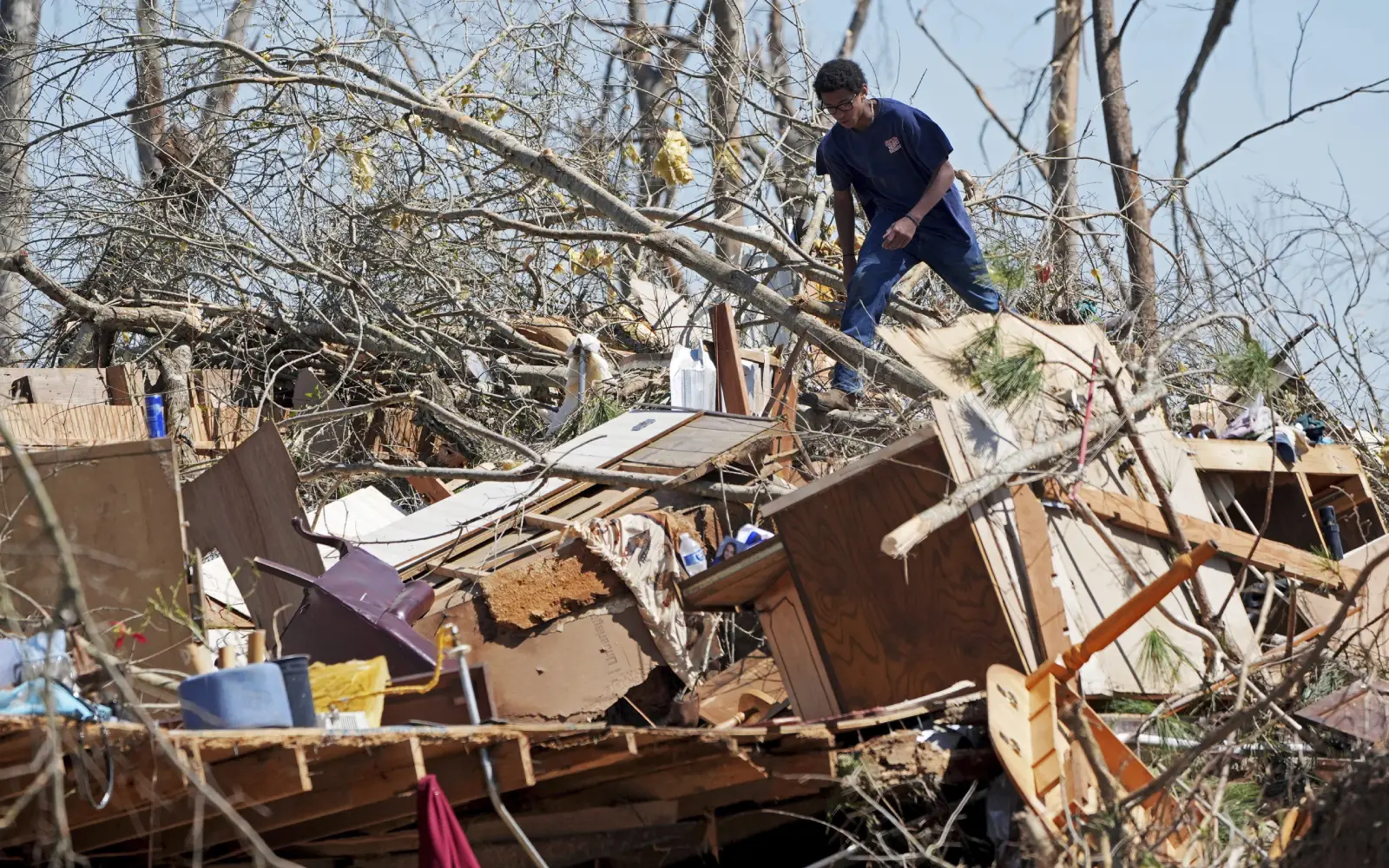A series of severe weather events across the United States over the past weekend has left a trail of destruction, claiming at least 36 lives and disrupting communities from the South to the Midwest and beyond. The storms, which brought fierce winds, tornadoes, and dangerous dust storms, have forced state and local officials to mobilize emergency responses while residents try to rebuild shattered lives.
A Nation in the Grip of Severe Weather
In a stark reminder of nature’s unpredictable fury, multiple states were battered by extreme weather conditions that led to widespread damage and tragic loss of life. As meteorologists tracked a surge of tornadoes and powerful wind events, communities across six states struggled to cope with the aftermath. Early assessments indicate that at least 36 people lost their lives during the relentless onslaught of storms that moved swiftly across regions, while hundreds more sustained injuries and thousands of homes were affected by power outages and structural damage.
The National Weather Service had issued multiple warnings as the severe weather system swept through the Midwest and South, with portions of Pennsylvania, New York, and the Mid-Atlantic still under threat from damaging winds and tornadoes. These advisories underscored the unpredictable nature of the storm system, compelling emergency services to remain on high alert.
Federal Response and Presidential Assurance
In response to the escalating crisis, President Donald Trump addressed the nation in a statement expressing his deep sorrow over the tragic loss of life. “Thirty-six innocent lives have been lost, and many more families are facing unspeakable devastation,” the president said, emphasizing that the federal government was fully engaged in efforts to support affected communities. To bolster local response efforts, President Trump announced that the National Guard had been deployed to Arkansas—a move designed to help state and local officials manage rescue operations, distribute aid, and assist in the recovery process.
This decision reflects an understanding of the significant challenges that come with coordinating disaster relief across multiple states. By mobilizing additional resources, federal leaders hope to ensure that relief efforts are both timely and efficient, addressing immediate needs such as medical care, shelter, and utility restoration for the many households affected by the severe weather.
Missouri: The Epicenter of Tragedy
Among the states hardest hit by the weekend’s storms was Missouri, which reported the highest number of fatalities with 12 deaths across five counties. Missouri’s highway patrol took to social media to relay the grim news, and state officials warned that the full extent of the destruction was still unfolding. Governor Mike Kehoe noted that widespread devastation was evident across 27 counties, and at least one resident remained missing amid the chaos.
In Butler County, the situation was particularly dire. Emergency management director Robbie Myers provided a harrowing account of the damage: over 500 homes, a local church, and even a grocery store were reported destroyed. The catastrophic impact extended to a mobile home park, which, according to Myers, was completely obliterated. One local resident, speaking to reporters, reflected on the stark contrast between those who had lost everything and those who still had shelter to return to—a poignant reminder of the human toll behind the statistics.
Devastation Across the Region
Missouri’s tragedy was mirrored in other parts of the country. In Mississippi, Governor Tate Reeves reported that six lives were lost, with the fatalities scattered across Covington, Jefferson Davis, and Walthall counties. Alongside the fatalities, preliminary estimates revealed that 29 people had sustained injuries statewide and that storm damage affected 21 counties. These numbers underscore the extensive reach of the storm system and the varied nature of its impact, from heavy rainfall and wind damage to flooding and tornados.
In Arkansas, the weather’s toll was similarly severe. The state’s Department of Emergency Management confirmed three deaths and 32 injuries as a direct result of the violent weather. The deployment of the National Guard in Arkansas is part of a broader strategy to ensure rapid response and support to emergency teams working tirelessly to rescue stranded residents and secure hazardous areas.
Chaos on the Roads: The Kansas Dust Storm
While many of the storm impacts were related to tornadoes and high winds, Kansas experienced a different but equally deadly phenomenon. In Sherman County, a severe dust storm triggered a massive multi-vehicle collision that resulted in eight fatalities. The Kansas Highway Patrol reported that over 50 vehicles were involved in the crash, with many of those injured transported to local hospitals for urgent care. Dust storms, often underestimated in their potential for destruction, can drastically reduce visibility and create hazardous driving conditions—a fact that has been tragically underscored by this incident.
Impact Beyond the Heartland
The severe weather’s impact was not confined to the central United States. In Alabama, Governor Kay Ivey reported at least two fatalities while noting that damage had been observed in 52 out of the state’s 67 counties. The widespread nature of the storm’s effect in Alabama points to an ongoing challenge for local officials who are now tasked with coordinating repair efforts, assessing long-term damage, and providing critical support to families who have lost homes and livelihoods.
Similarly, Texas was not spared the brunt of these extreme weather events. Near Amarillo, dust storms led to multiple crashes, claiming the lives of three individuals. The Department of Public Safety in Texas attributed the tragic accidents directly to the hazardous conditions caused by the dust storm, highlighting yet another dimension of the severe weather’s impact.
The Uncertain Road Ahead
As the storm system continues to evolve, forecasters have warned that additional weather phenomena may emerge. With 39 tornadoes reported from Friday through Sunday, meteorologists are working around the clock to confirm the final count and assess the full scale of the tornado activity. The National Weather Service’s Weather Prediction Centre remains vigilant, advising residents in vulnerable areas to stay tuned to local advisories and to take necessary precautions if further severe weather is predicted.
The uncertainty and rapid pace of these events have added to the anxiety of communities still grappling with the aftermath. Officials across the affected states have urged residents to avoid unnecessary travel, secure damaged properties, and cooperate fully with emergency response teams. Local authorities are also coordinating with federal agencies to ensure that all available resources are directed where they are most needed.
A Wake-Up Call for Disaster Preparedness
Beyond the immediate loss and disruption, this series of events serves as a stark reminder of the importance of disaster preparedness. As extreme weather events become more frequent and intense, experts stress the need for robust infrastructure, improved early warning systems, and comprehensive emergency planning. While the current crisis has led to a rapid response by both state and federal agencies, long-term measures will be critical in reducing the human and economic toll of future disasters.
In the wake of the storms, community leaders and emergency management officials are calling for increased investment in weather monitoring and infrastructure resilience. The goal is not only to respond more effectively when disasters strike but also to build systems that can withstand the increasing intensity of such events—a challenge that demands the cooperation of local governments, federal agencies, and private stakeholders.
Coming Together in the Face of Adversity
The weekend’s events have left an indelible mark on the affected regions, with communities now faced with the dual challenge of mourning lost loved ones and rebuilding in the aftermath of widespread destruction. While the devastation is profound, there is also a strong sense of resolve among residents and local officials alike. Emergency response teams are working tirelessly to restore power, clear debris, and provide essential services to those in need.
As the nation reflects on the scale of the tragedy, the importance of solidarity and mutual aid has never been clearer. The coordinated efforts of federal, state, and local agencies, combined with the resilience of affected communities, underscore a collective determination to overcome the challenges posed by nature’s fury. In the face of such overwhelming adversity, every act of support and every resource deployed represents a step toward healing and recovery.
Looking Forward
In the coming days, a detailed assessment of the damage will inform future policy decisions regarding disaster preparedness and climate resilience. The deployment of resources such as the National Guard and the rapid response of emergency teams illustrate a commitment to saving lives and supporting communities, even as officials work to understand and mitigate the factors that contributed to the disaster.
While the current focus remains on rescue operations and immediate relief efforts, long-term recovery and rebuilding will require sustained attention and cooperation. The lessons learned from this devastating weekend will hopefully pave the way for improved infrastructure, better planning, and enhanced early warning systems to safeguard against future calamities.
The extreme weather that swept across the U.S. this weekend is a sobering reminder of the power of nature and the importance of preparedness. As communities begin the arduous process of recovery, the resilience and unity displayed by residents and officials offer a beacon of hope amid the darkness of loss. The road to rebuilding may be long and fraught with challenges, but the commitment to protect and support every citizen remains unwavering.
In conclusion, as the nation mourns the tragic loss of 36 lives and counts the cost of widespread damage, the response of government officials, emergency teams, and local communities stands as a testament to American resolve. The path forward will be defined not only by recovery efforts but also by the determination to learn from these events and better prepare for the future.










